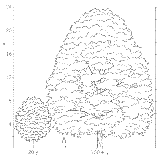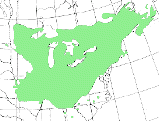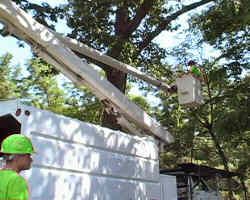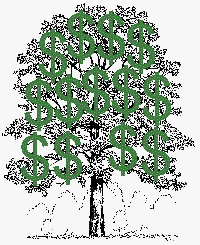



sugar maple
Acer saccharum
Sugar maple is a large, deciduous tree with a mature height of 60 to 75 feet with a spread of 40 to 50 feet. This tree is appropriate for medium to large yards, parks, and boulevards with wider planting strips. The specie does best on well-drained, moderately moist soils. Verticillium wilt is the only
major pathogen to this tree, though sapsuckers do like to peck holes in it in the spring. Late summer scorch and “leaf-tatters” are a concern on exposed sites. The cultivars ‘Legacy,’ ‘Green Mountain,’ ‘Caddo,’ and ‘Commemoration’ do much better on these sites.

Plant illustration by Jenny M. Lyverse, from Landscape Plants for Eastern North America, 2nd Edition, Harrison L. Flint Author
Range map modified from USDA Forest Service Silvics of North America Web site - www.na.fs.fed.us/spfo/pubs/
silvics_manual/Volume_2/acer/
saccharum.htm
Utility Pruning: The Necessary Evil

|
Safe, dependable electric service just does not happen. Many people, including myself, do not understand all the details of electricity. We just know we want the coffeemaker to work in the morning. Most of the time it is that easy for us. Reality is hard working people maintain the electrical grid. This includes pruning trees along electric distribution and transmission lines.
Utilities prune or clear utility lines to reduce outages caused by tree limbs rubbing on the lines and by storm damaged trees from breaking the lines. There are two schools of thought on how this is done. The old way is to cut everything back to a given distance, regardless of where the cut is. This usually leaves severely topped trees behind. The newer method removes branches in such a way as to reduce health problems and still improve utility line safety and clearance.
This new way is called directional or target pruning. Essentially, it involves removing branches at a parent branch or the trunk and removing it correctly to leave the smallest wound possible on the tree. This provides obvious benefits to the tree and helps the utility in the long run. Improperly pruned (topped trees or stubbed branches) trees respond by regrowing new branches quickly back into the lines, where properly pruned branches and trees utilize the plants normal growth hormones to reduce or eliminate the quick regrowth. The lack of this regrowth will save the utility and their clients next time they return to an area to prune trees along the lines. Carthage Water and Electric Plant has started using the directional methods to one save money in the long run and to work towards qualifying for the Tree Line USA recognition program. There are a few other utilities in the area that have also started to use this method.
Communities can assist their utility by enacting ordinances that do not allow trees that grow more than 30 feet from being planted under or within 30 feet of an utility line. This becomes a win-win for the community, the individual tree owner, and the utility. If you are interested in learning about directional pruning, Tree Line USA, or tree ordinances contact Jon Skinner ( Jon.Skinner@mdc.mo.gov) at 417-629-3423.
Shake the Money Tree

|
Money does not literally grow on trees, but trees do provide a return on investment. Unfortunately, many see trees as an luxury expense, but in reality properly planted, located, and maintained trees provide a financial return greater than their costs.
It is well documented that properly placed trees can reduce heating and cooling expenses (a return on investment). Trees provide the most cooling benefit when they shade the West, Southwest and East, Southeast portions of a building. They provide the most heating benefit when windbreaks are designed to protect from northern and westerly winds.
Business districts benefit when trees are there and properly maintained. The payoff comes from happier, longer staying, and better purchasing customers. Research has found visitors to a business district with trees find the visual quality better than other treeless areas, perceive these areas as more pleasant, better maintained, have a higher quality products and helpful merchants. The customers will also travel farther, more often, and stay longer in a business area with trees and are willing to pay 9 to 12 percent more for the products.
Communities in general can also benefit from their trees. A Modesto, CA study found that a single large shade tree reduced cooling costs by 9 percent, absorbed 10 pounds of air pollutants, intercepted 760 gallons of rainwater, removed 330 lbs of CO2 (90 Lbs C), and added 1 percent to property value every year. The rainwater interception is of particular interest now that the EPA requires all communities to control stormwater runoff both in quantity and quality. The cost of dealing the 760 gallons of water can easily be attained by civil engineers.